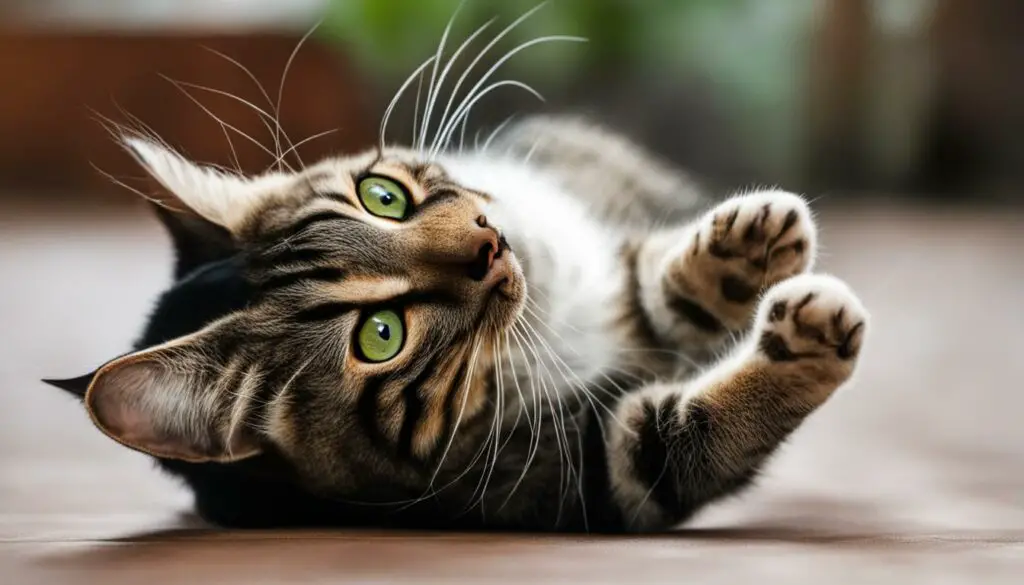As a cat owner, you may have witnessed your furry friend rolling on their back and meowing, leaving you puzzled about the meaning behind this behavior. Understanding why cats engage in this quirky behavior is key to comprehending their feline nature and building a stronger bond with them.
Cat behavior experts and veterinarians have extensively studied this behavior, providing valuable insights into its causes and significance. In this article, we will delve into the fascinating world of cats, deciphering the reasons behind their rolling on back and meowing behavior.
Key Takeaways:
- Cats roll on their backs and meow for various reasons, including seeking attention, expressing playfulness, relieving itching, or signaling reproductive readiness.
- Understanding cat behavior involves decoding their vocalizations, body language, and overall mood.
- Observing cues, respecting boundaries, and providing for their physical and emotional needs are essential for fostering a loving and respectful relationship with your cat.
- Interpreting cat rolling behavior requires caution, as exposing their bellies does not always indicate a desire for belly rubs.
- By studying their behavior, we can deepen our understanding of our feline companions, enabling us to build a stronger bond based on trust and empathy.
Cat Rolling Behavior Observed
When it comes to cat behavior, one peculiar action that often catches our attention is their tendency to roll around on the ground. This behavior can be quite intense, with cats flailing their feet and twitching their tails. It may even include vocalizations that make it appear as though they are in distress. However, studies have shown that rolling behavior is actually quite common in both wild and domestic cats, indicating that it is deeply ingrained in their natural behavior.
Cat rolling behavior is observed when cats lie on their backs and begin to roll from side to side, often rubbing against the ground. They may also engage in a series of quick turns and flips, displaying a playful and exuberant energy. The reasons behind this behavior are multifaceted and can vary from cat to cat.
One possible explanation for cat rolling is that it serves as a way for cats to mark their scent. By rubbing their bodies against the ground, they leave behind their pheromones, which can help establish their territorial boundaries and communicate with other cats in the area. Rolling behavior can also be a way for cats to stretch their muscles and relieve tension, similar to how humans might engage in stretching exercises. So, the next time you see your cat rolling on the ground, know that it’s not necessarily a cause for concern, but rather a fascinating glimpse into their instinctual behaviors.
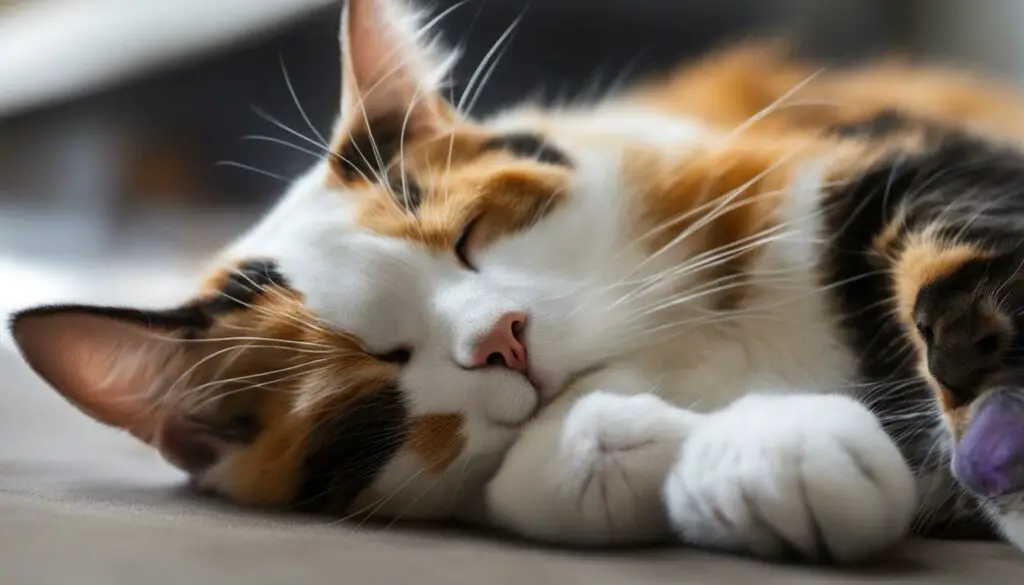
Table: Common Behaviors Observed During Cat Rolling
| Behavior | Description |
|---|---|
| Flailing Feet | During rolling, cats may kick their feet in the air or swipe them against the ground in a playful manner. |
| Tail Twitching | As cats roll, their tails may twitch or wag, indicating excitement or pleasure. |
| Vocalizations | Some cats may vocalize during rolling, which can range from purring and chirping to meowing and trilling. |
| Rubbing Against Objects | Cats often rub against nearby objects or even their humans while rolling, which is a way of marking their territory and showing affection. |
Understanding cat rolling behavior can provide insights into their natural instincts and ways of communication. It’s important to observe their body language, take note of any accompanying vocalizations, and consider the context in which the behavior occurs. By doing so, we can deepen our understanding and appreciation for these fascinating creatures that share our lives.
Causes for the Quirk
The behavior of cats rolling on their backs can be attributed to several causes. It is important to understand these causes in order to better interpret and respond to this quirky behavior.
Seeking Attention
One possible reason for cats rolling on their backs is to seek attention. This behavior can be their way of showing that they want interaction with their owners or other animals. It is often accompanied by head rubbing and purring, indicating their social nature.
To provide the right kind of attention, it is important to read your cat’s body language and respond accordingly. Not all cats enjoy belly rubs, so it’s best to avoid forcing physical contact and instead observe their cues to understand their intentions.
Marking Scent
Another reason for cat rolling behavior is the marking of scent. Cats have scent glands on various parts of their body, including their back. By rolling on their backs, they can leave their scent on surfaces, marking their territory. This behavior is particularly common in multi-cat households where cats establish their boundaries.
Understanding this behavior can help create a harmonious environment for all cats in the household, as it allows them to establish their presence and minimize conflicts.
Back Massage, Itching, and Play
Some cats may roll on their backs to enjoy a back massage. Rolling can provide a pleasant sensation that helps them relax and feel comfortable. Additionally, cats may roll on their backs to alleviate itching caused by dry skin or the presence of parasites like fleas or mites.
This behavior can also be an invitation to play. Rolling on the back during play indicates a cat’s playfulness and engagement. It can be their way of expressing their desire to join in the fun and interact with their human family or other animals.
Understanding the various causes for cat rolling behavior allows us to better understand and connect with our feline companions. By responding appropriately and providing for their needs, we can strengthen the bond between humans and cats.
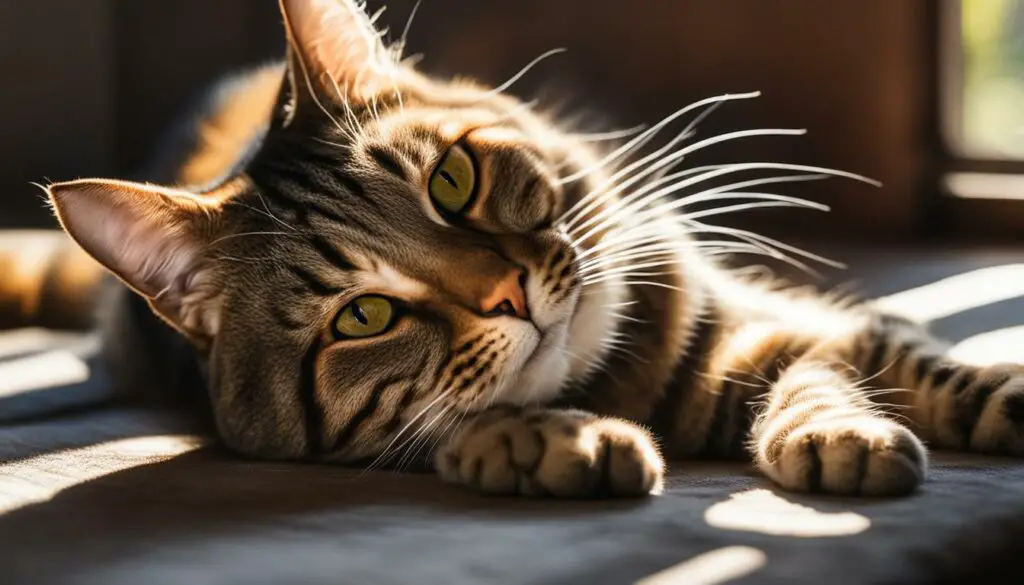
Cat Vocalizations and Their Meanings
Cats have a wide range of vocalizations, each with its own unique meaning. By understanding their vocal cues, we can better interpret their needs and emotions. Let’s explore some common cat vocalizations and their meanings:
Loud Meows
Loud meows can be attention-seeking behavior or a warning sign. Your cat may be trying to get your attention or communicate that they are in distress. It’s important to assess the situation and respond accordingly.
Quiet Meows
Quiet meows can indicate exhaustion or a desire for interaction. Your cat may be signaling that they need some rest or are seeking your company. Pay attention to their body language to gauge their needs.
Purring
Purring is a well-known feline behavior that usually signifies contentment. Cats often purr when they feel relaxed and comfortable. However, purring can also be a self-comforting behavior, especially in stressful situations.
Hissing or Spitting
Hissing or spitting is a defensive vocalization that cats use when they feel threatened or stressed. It’s a warning sign that they are not comfortable with the current situation. Give your cat space and time to calm down.
Yowls or Howls
Yowls or howls can indicate pain or distress. If your cat is making these vocalizations, it’s essential to investigate further and determine the cause of their discomfort. Consult with a veterinarian if necessary.
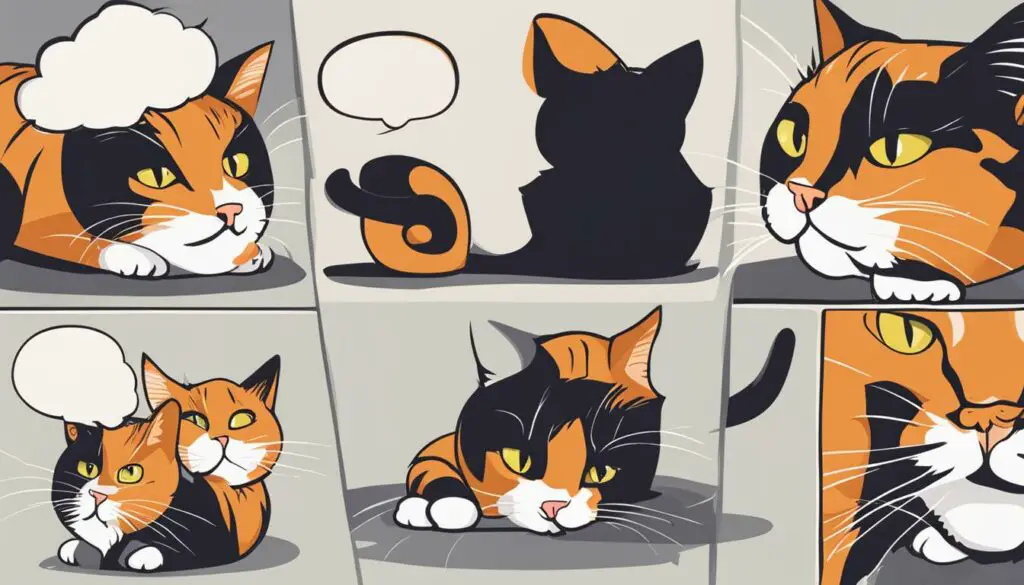
Understanding and interpreting cat vocalizations can greatly enhance our communication with them. By paying attention to the context, body language, and other cues, we can better meet their needs and ensure their well-being.
Cat Body Language and Their Meanings
Cats communicate not only through vocalizations but also through their body language. Understanding their various gestures and movements can give us valuable insights into their emotions and intentions. Here are some common cat body language cues and their meanings:
Scratching
One of the most notable feline behaviors is scratching. Cats scratch to maintain their claws, mark their territory, and stretch their muscles. It’s their way of saying, “This is mine!” If your cat is scratching furniture or other inappropriate items, providing a scratching post or pad can redirect this behavior.
Jumping
Cats are agile creatures known for their impressive jumping skills. When your cat jumps on you or attacks your feet, it can be a sign of playfulness or a desire for stimulation. Providing interactive toys or engaging in play sessions can help satisfy their energetic nature.
Kneading Claws
Have you ever noticed your cat gently kneading their paws on a soft surface, like your lap or a blanket? This behavior is often accompanied by purring and indicates contentment. It harks back to their kittenhood when they kneaded their mother’s belly to stimulate milk production.
Rubbing
When a cat rubs its body against you or objects, it’s a form of marking territory. This behavior allows them to leave their scent and establish ownership. It’s a sign of familiarity and comfort, indicating that they consider you part of their trusted circle.
Biting
Cats may resort to biting when they are feeling overwhelmed, agitated, or in pain. It’s essential to pay attention to their body language and respond accordingly. If your cat displays aggressive biting behavior, consult with a veterinarian or cat behaviorist for guidance.
Understanding your cat’s body language can help you better care for their physical and emotional needs. Remember that each cat is unique, so it’s crucial to observe their behavior in context and develop a personalized understanding of their cues.
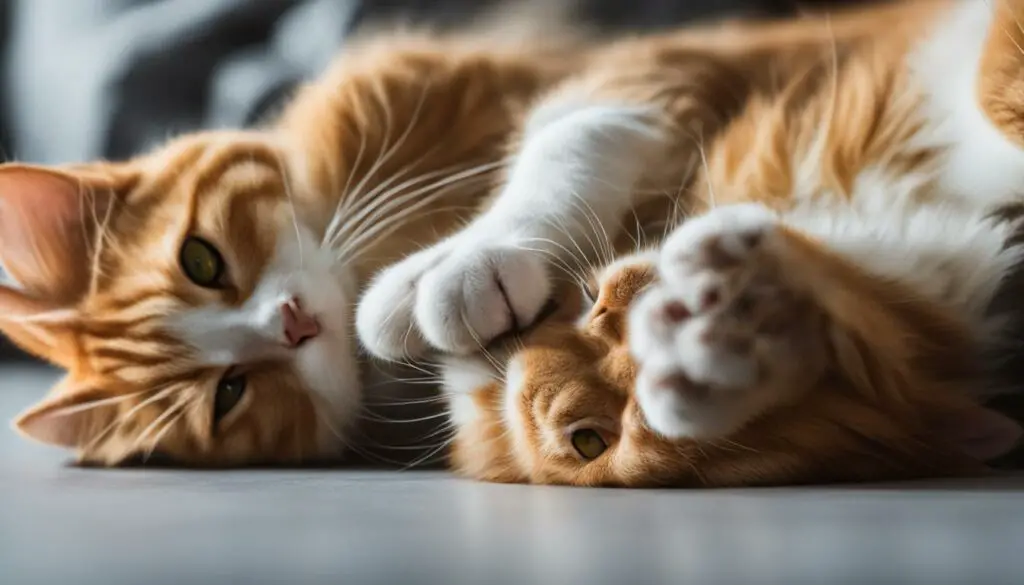
Cat Mood Tracking
Understanding your cat’s mood and behavior is essential for providing them with the care and attention they need. Cats experience a range of emotions, from contentment and playfulness to being over-stimulated, nervous, frightened, defensive, or angry/territorial. By observing their body language and paying attention to their vocalizations, you can gain valuable insights into their current mood.
A content cat will display relaxed body posture, such as a relaxed tail and ears, and may purr to indicate their happiness. Playful cats will have forward ears, an upright tail, and dilated pupils, showing their excitement and engagement. However, it’s important to recognize when playfulness turns into over-stimulation, as this can lead to aggression and restlessness.
When a cat feels nervous, frightened, or defensive, their body language and behavior will reflect their discomfort. They may exhibit defensive body postures, such as flattened ears, arched back, and dilated pupils. These cats may try to find a place to hide or try to escape from the situation. It’s crucial to respect their need for space and provide a calm and safe environment.
Anger or territorial behavior in cats can manifest as aggressive displays, such as hissing, growling, or swatting. Cats may also exhibit dominant behaviors, such as marking their territory or engaging in territorial disputes with other cats. It’s important to identify the triggers for such behavior and provide appropriate training and environmental enrichment to help manage these situations.
| Cat Mood | Body Language |
|---|---|
| Content | Relaxed body posture, purring |
| Playful | Forward ears, upright tail, dilated pupils |
| Over-stimulated | Restlessness, aggression, excessive energy |
| Nervous/Frightened/Defensive | Defensive body postures, flattened ears, arched back, dilated pupils |
| Angry/Territorial | Hissing, growling, swatting, marking behavior |
![]()
Being attuned to your cat’s moods allows you to respond appropriately and provide the right kind of support and care. By recognizing signs of contentment, playfulness, over-stimulation, nervousness, and territorial behavior, you can create an environment that is conducive to their well-being. Remember, every cat is unique, so observing their individual cues and preferences is crucial for building a strong bond with your feline companion.
Itching and Rolling on the Ground
One common reason why cats roll on their backs is to relieve itching caused by various factors. Cats may experience dry skin, which can lead to discomfort and itching. Additionally, cats are susceptible to parasites such as fleas and mites, which can also cause itching and irritation. When cats feel the need to relieve the itch, they may roll on the ground to scratch the affected areas and find temporary relief.
It’s essential for cat owners to pay close attention to their cats’ behavior and check their fur and skin regularly for signs of irritation or the presence of parasites. If you notice that your cat is frequently rolling on the ground and exhibiting signs of itching, it’s important to consult with a veterinarian. They can help identify the underlying cause, such as dry skin or an infestation, and provide appropriate treatment options.
| Possible Causes of Itching in Cats | Symptoms |
|---|---|
| Dry skin | Flaky or scaly skin, excessive scratching |
| Flea infestation | Flea dirt, excessive grooming, small red bumps |
| Mite infestation | Intense itching, hair loss, crusty skin |
Addressing the underlying cause of itching is crucial to alleviate your cat’s discomfort and reduce the need for frequent rolling behavior. If dry skin is the issue, your veterinarian may recommend dietary changes or supplements to improve your cat’s skin condition. In the case of parasites, appropriate flea treatments or medication to eliminate mites will be prescribed. Regular grooming and maintaining a clean living environment can also help prevent itching caused by external irritants.
By understanding the connection between itching and rolling behavior, cat owners can take proactive measures to ensure their feline companions are comfortable and free from irritating skin conditions. Regular veterinary care, proper grooming, and a clean living environment all contribute to a healthier and happier cat.
Attention-Seeking Behavior
When your cat rolls on their back, it can be a sign of attention-seeking behavior. Cats are social creatures and rolling is their way of indicating that they want interaction from you. This behavior is often accompanied by head rubbing and purring, which further emphasizes their desire for attention.
Cat rolling for attention is an invitation for you to engage with them. They enjoy the physical contact and the opportunity to bond with their human companions. By responding to their rolling behavior and giving them the attention they crave, you can strengthen your bond with your cat and make them feel loved and valued.
“My cat loves to roll on her back and make eye contact with me, purring and rubbing her head against my hand. It’s her way of saying, ‘Hey, I want some attention and affection!’ I always make sure to give her the pets and cuddles she’s asking for—it’s our special bonding time.”
| Signs of Attention-Seeking Behavior in Cats | Meaning |
|---|---|
| Rolling on back | Desire for attention and interaction |
| Head rubbing | Marking you with their scent, a sign of affection |
| Purring | Expressing contentment and happiness |
It’s important to note that some cats may have sensitive bellies and may not enjoy having their stomachs touched. Always observe your cat’s body language and respond accordingly. If they show signs of discomfort or try to retract their belly when you attempt to give them attention, it’s best to respect their boundaries and find other ways to interact and show them affection.
Stretching and Rolling After Sleep
After a restful sleep, cats, like humans, have the natural instinct to stretch their muscles. This is often accompanied by rolling on their backs, which allows them to stretch their back, legs, and neck. Rolling after sleep provides cats with a way to loosen up their muscles and increase blood flow, promoting overall flexibility and mobility.
During this stretching and rolling behavior, cats may display a sense of ease and contentment. Their body language is relaxed, and they may even purr softly. It’s essential to respect their space during this time, as sudden movements or attempts to pet them may startle or irritate them. Observing their stretching routine and giving them a moment to finish before engaging in physical contact can ensure a harmonious interaction.
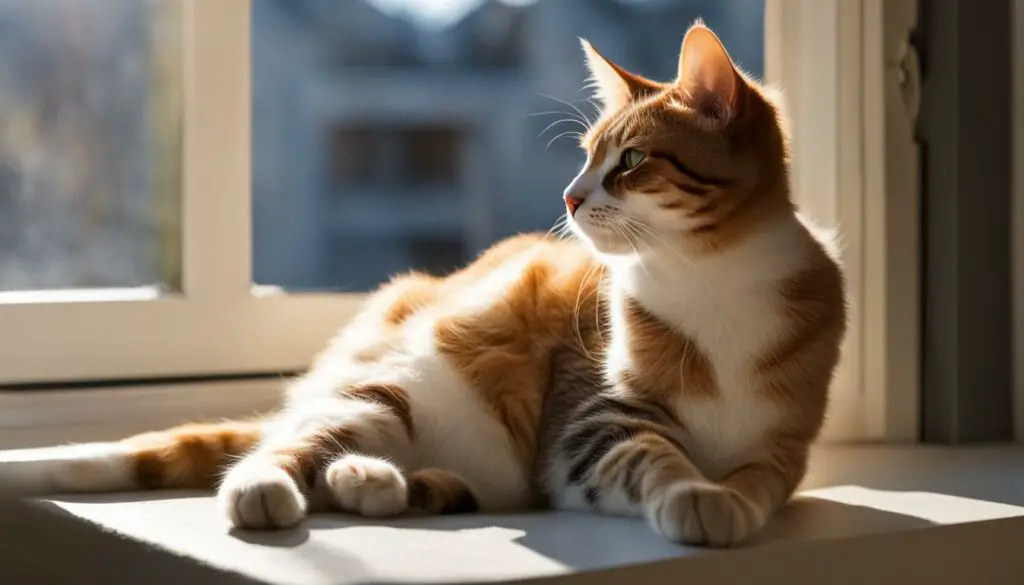
Benefits of Stretching for Cats
Stretching after sleep is not only a natural behavior for cats, but it also offers several benefits. Here are some of the advantages of stretching for our feline companions:
- Improved circulation: Stretching helps improve blood circulation, delivering oxygen and vital nutrients to their muscles.
- Maintaining muscle tone: Regular stretching can help cats maintain flexible and toned muscles, keeping them agile and ready for their daily activities.
- Enhanced joint mobility: Stretching exercises the joints, promoting their range of motion and preventing stiffness.
- Promotion of mental and physical well-being: Stretching not only benefits cats physically but also contributes to their mental well-being by reducing stress and promoting relaxation.
| Benefits of Stretching for Cats | |
|---|---|
| Improved circulation | Enhances blood flow, delivering oxygen and nutrients to muscles |
| Maintaining muscle tone | Keeps muscles flexible and toned |
| Enhanced joint mobility | Promotes the range of motion in joints |
| Promotion of mental and physical well-being | Reduces stress and promotes relaxation |
“Watching my cat stretch and roll after sleep is such a joy. It’s a beautiful reminder of their natural instincts and their need for physical and mental well-being. I make sure to give my cat the space and time to complete their stretching routine, respecting their personal boundaries. Understanding and supporting their natural behaviors is crucial in building a strong and loving bond.”
Cat Mating Behavior: Rolling to Signal Interest
When it comes to cat behavior, rolling on the back can serve as a significant communication method, particularly in the context of mating. Female cats often engage in this behavior to signal their reproductive readiness and attract male cats. Rolling on the back releases pheromones, chemical messages that communicate their interest. It’s a natural instinct driven by their hormonal and biological responses.
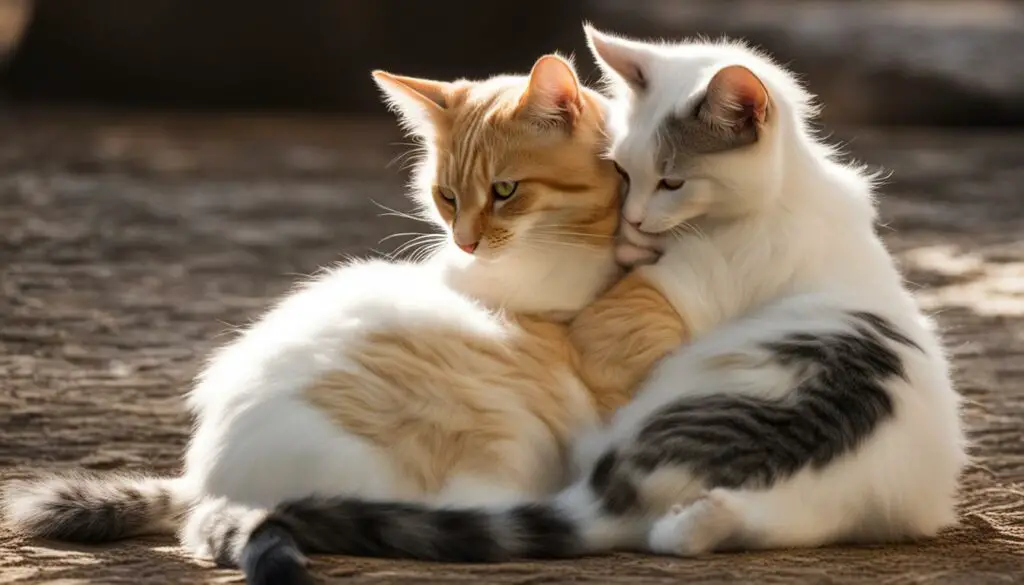
This rolling behavior, accompanied by the release of pheromones, acts as a calling card for potential mates. Male cats, upon detecting these chemical messages, may be drawn to the female’s scent and display interest in mating. It is important to note that this behavior is primarily observed in unspayed female cats.
Understanding cat mating behavior can help cat owners make informed decisions regarding spaying and preventing unwanted pregnancies. Spaying female cats not only prevents unplanned litters but also offers health benefits for the cat. It reduces the risk of certain reproductive diseases and eliminates the potential stress associated with mating behaviors.
Cat Playfulness and Rolling: Understanding Interaction with Humans and Other Animals
Playing is an essential part of a cat’s life, and rolling during play is a common behavior observed in felines. Whether it’s with their human family or other animals, cats use rolling as a way to show their playfulness and engage in interactive fun. It’s a delightful sight that brings joy to both cats and their companions.
During play, cats may initiate rolling as a way to invite others to join in the fun. It’s their way of saying, “Let’s play together!” Rolling on their backs can also be a playful gesture to showcase trust and vulnerability. When a cat feels comfortable and safe, they are more likely to engage in this behavior as an expression of their playful nature.
“Rolling during play is a delightful sight that brings joy to both cats and their companions.”
When interacting with a playful cat, it’s important to engage them in appropriate play activities, such as using toys that stimulate their natural instincts. Feather wands, laser pointers, and interactive puzzle toys can provide mental and physical stimulation, keeping your cat entertained and satisfied. Remember to monitor play sessions to ensure the safety of both your cat and yourself.
Cat Playfulness and Human Bonding
Engaging in play with your cat not only provides them with physical exercise and mental enrichment but also strengthens the bond between you. The act of playing together fosters a sense of trust and companionship, enhancing the relationship you share with your feline friend. It allows for positive interaction, builds mutual understanding, and creates lasting memories.
| Benefits of Play for Cats | Benefits of Play for Humans |
|---|---|
| Physical exercise | Stress relief |
| Mental stimulation | Opportunity for bonding |
| Prevention of behavior issues | Enhanced understanding of cat behavior |
The table above highlights the benefits of play for both cats and humans. By engaging in interactive play sessions, you can provide a stimulating environment for your cat while also enjoying the positive effects it has on your own well-being.
Remember, each cat is unique, and their play preferences may vary. Observe your cat’s behavior and adapt playtime to suit their individual needs. Enjoy the moments of playfulness and rolling, creating a joyful and fulfilling relationship with your feline companion.
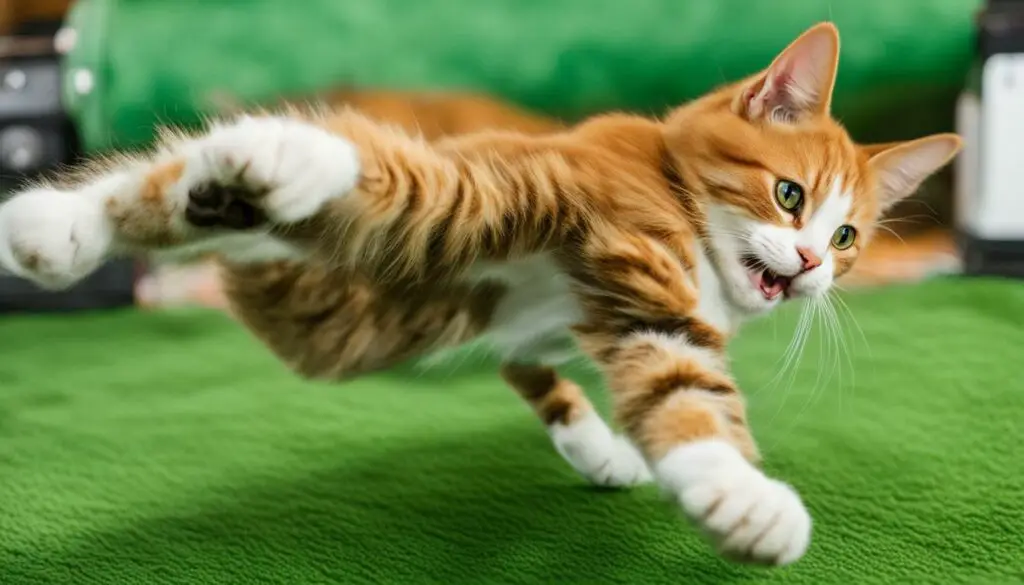
Interpreting Rolling Behavior
Understanding why cats roll on their backs can be a fascinating endeavor. However, it’s important to interpret their behavior correctly. When a cat exposes their belly, it doesn’t always mean they want belly rubs. In fact, their tummies are often sensitive and should be approached with caution. Instead, it’s crucial to read their body language and respond accordingly.
When a cat rolls on their back, they may be displaying a sense of trust and vulnerability. It’s a way for them to communicate that they feel safe and comfortable in their environment. However, it can also be a sign of playfulness or an invitation to engage in interactive play. If your cat is rolling around and exhibiting other playful behaviors like batting at toys or chirping, it’s a good indication that they’re in a playful mood.
On the other hand, if your cat’s rolling behavior is accompanied by flattened ears, dilated pupils, or a swishing tail, it may be a sign of distress or agitation. These signs suggest that your cat may not be receptive to physical contact and may need some space. It’s important to respect their boundaries and give them the opportunity to calm down.
Caution with Belly Rubs
While many cats enjoy a gentle belly rub, it’s essential to approach this activity with caution. Not all cats appreciate having their bellies touched, and some may react defensively if they feel threatened or uncomfortable. Before attempting a belly rub, observe your cat’s body language for cues of relaxation and trust. If they expose their belly willingly and seem relaxed, you can slowly and gently stroke their belly. However, if your cat tenses up, tries to nip or scratch, or shows signs of discomfort, it’s best to refrain from touching their belly.
Remember, every cat is unique, and their preferences for physical contact can vary. It’s crucial to establish a bond of trust with your cat and understand their individual boundaries and preferences. By observing their body language and responding accordingly, you can ensure that your interactions with your feline friend are enjoyable and respectful.
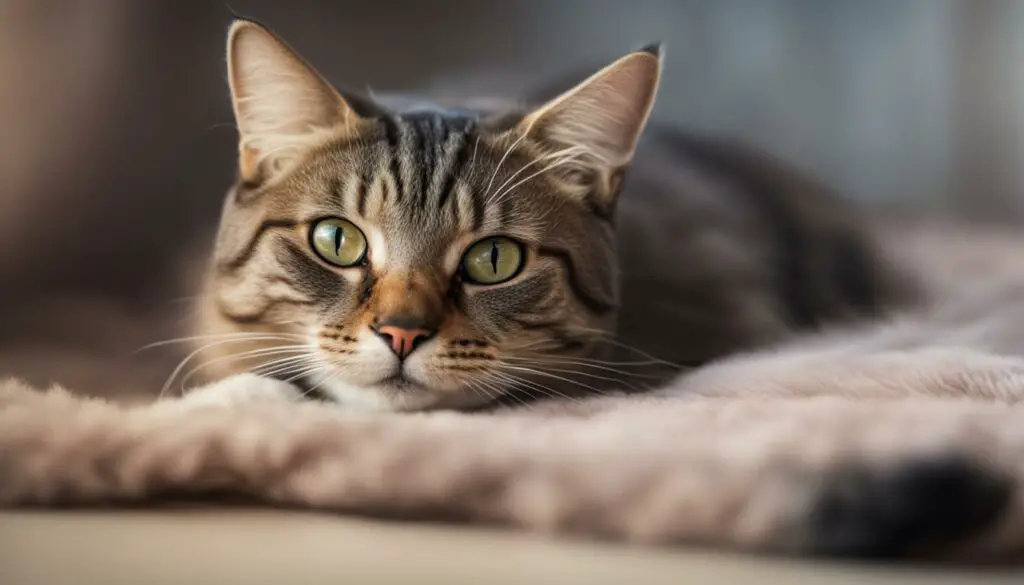
Reading Body Language
Understanding cat body language is key to interpreting their rolling behavior. Cats communicate through subtle cues, and being able to read their body language can help you understand their emotions and intentions. Here are a few key body language signals to look out for:
- Ears: Forward-facing ears generally indicate a relaxed and content cat, while flattened or backward-facing ears can indicate fear or aggression.
- Tail: A relaxed, slightly curved tail is a sign of contentment, while a puffed-up or swishing tail may indicate agitation or arousal.
- Pupils: Dilated pupils can signify excitement or fear, while constricted pupils may indicate aggression or discomfort.
- Posture: A relaxed and open posture with a slightly arched back suggests a calm and comfortable cat, while a low crouched posture can indicate fear or readiness to pounce.
By paying attention to these subtle cues and combining them with other behavioral signals, such as vocalizations and overall body tension, you can gain deeper insights into your cat’s emotions and better understand their rolling behavior.
Interpreting Cat Vocalizations and Body Language
Understanding our feline companions requires more than just listening to their meows and purrs. Cats communicate through a combination of vocalizations and body language, which can provide valuable insights into their needs, emotions, and intentions. By interpreting cat vocalizations and body language, we can build a deeper understanding of feline communication.
Interpreting Cat Vocalizations
When deciphering cat vocalizations, it’s important to pay attention to the context and accompanying body language. Meowing can have different meanings, from a simple greeting to a request for food or attention. Loud meows may indicate urgency or discomfort, while soft, melodic meows can display contentment. Understanding the nuances of their vocalizations can help us respond appropriately to their needs.
Decoding Cat Body Language
Cat body language is equally important in understanding their communication. Tail position, ear position, and body posture can convey a range of emotions, from relaxation to fear or aggression. A relaxed cat typically has their tail held low or gently swaying, while an upright and rigid tail may indicate agitation. Ears held forward can signal interest and engagement, while flattened ears may indicate fear or anxiety. Observing their overall body language can help us gauge their comfort level and respond accordingly.
By honing our ability to interpret cat vocalizations and body language, we can better understand our feline friends and meet their needs effectively. It’s essential to pay attention to the context, observe their behaviors holistically, and respond with empathy and understanding.
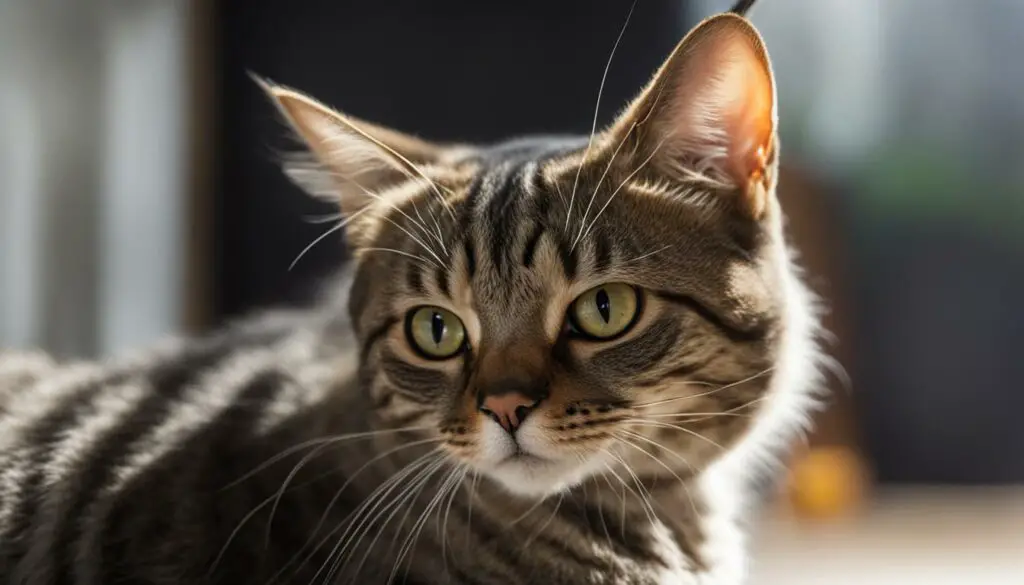
Deciphering Cat Moods
Understanding our cats’ moods is essential for providing them with the care and attention they need. Cats, like humans, experience a range of emotions, from contentment and playfulness to aggression and fear. By observing their body language, vocalizations, and overall behavior, we can decipher their mood and take appropriate action.
When a cat is content, they will display relaxed body posture and engage in activities such as purring. Playful cats may show excitement through forward ears, an upright tail, and dilated pupils. It’s important to create a safe and stimulating environment for playtime to satisfy their natural instincts.
Aggression in cats can be triggered by various factors, including fear, territorial behavior, and discomfort. Cats may exhibit defensive body language or engage in aggressive behaviors such as hissing, growling, or swatting. It’s crucial to respect their boundaries and provide them with a calm environment to help alleviate their aggression.
| Mood | Behavior |
|---|---|
| Contentment | Relaxed body posture, purring |
| Playfulness | Forward ears, upright tail, dilated pupils |
| Aggression | Hissing, growling, swatting |
| Fear | Defensive body language, attempted retreat |
| Territorial Behavior | Marking, hissing, growling |
Understanding our cats’ moods helps us create a supportive and nurturing environment for them. By paying attention to their behavior, we can address their needs and ensure they feel safe and loved.
Monitoring and Responding to Cat Moods
To decipher cat moods effectively, it’s important to be attentive and responsive. Regularly monitoring their behavior and body language can help identify changes in mood or any potential underlying health issues. If you notice significant shifts in their behavior, such as sudden aggression or withdrawal, it’s advisable to consult a veterinarian to rule out any medical causes.
Remember that each cat is unique, and their moods may vary based on their personality and life experiences. Spend quality time with your cat, observe their reactions to different stimuli, and adapt your interactions accordingly. Providing a calm and secure environment, enriched with toys, scratching posts, and hiding spots, can help promote a sense of well-being and contentment.
- Monitor your cat’s behavior and body language for changes.
- Consult a veterinarian if you notice significant shifts in mood.
- Adapt your interactions based on your cat’s individual needs and preferences.
- Create a stimulating environment with toys, scratching posts, and hiding spots.
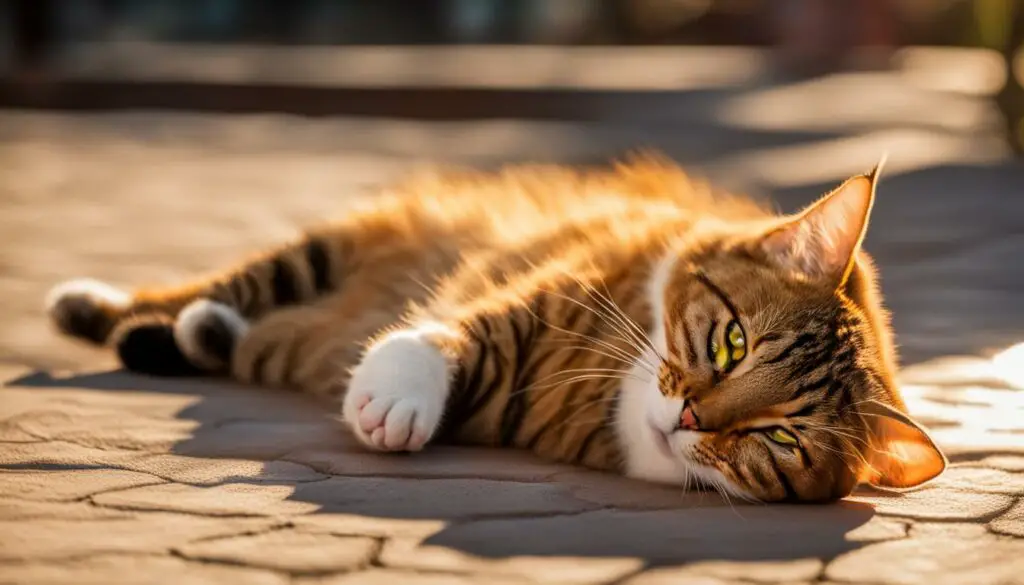
Understanding our cats’ moods is an ongoing process that requires patience and empathy. By deciphering their behavior and responding appropriately, we can build a harmonious and loving relationship with our feline companions.
Tips for Cat Interaction and Understanding
When it comes to interacting with our feline friends, understanding their behavior is key. Cats have their own unique ways of communicating, and being able to read their cues and respond appropriately can strengthen our bond with them. Here are some tips for better cat interaction and understanding:
- Observe Cat Cues: Pay attention to your cat’s body language, facial expressions, and vocalizations. These can provide valuable insights into their feelings and intentions. For example, a tail held upright often indicates a happy or confident cat, while a swishing tail may indicate agitation or annoyance.
- Respect Personal Space: Cats have a need for personal space, so it’s important to respect their boundaries. Avoid forcing physical contact or overwhelming them with attention. Instead, let them approach you on their terms and provide a safe and quiet space where they can retreat when needed.
- Provide Enrichment: Cats are natural hunters and need mental and physical stimulation. Make sure to provide toys, scratching posts, and interactive play sessions to satisfy their natural instincts. Engaging in playtime with your cat is not only fun but also helps build a stronger bond between you.
Remember, every cat is unique, and what works for one may not work for another. Patience and understanding are key when it comes to building a positive relationship with your feline companion. By taking the time to learn their individual preferences and needs, you can create a harmonious environment that promotes their health and happiness.
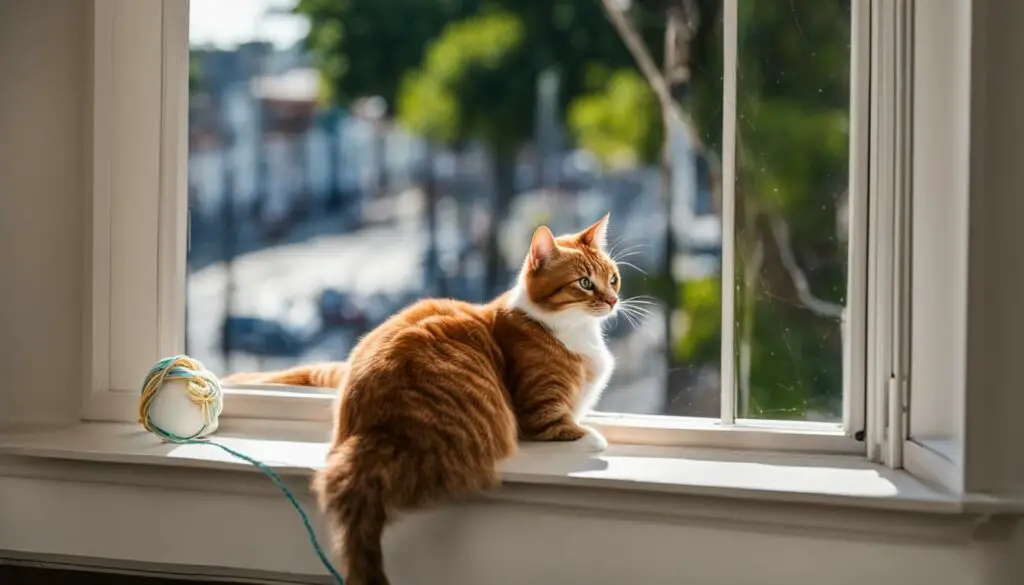
Conclusion
Understanding your cat’s behavior, including their rolling behavior, is key to building a strong bond with them. By decoding their messages through observation and interpretation, you can deepen your connection with your feline companion.
Cat rolling behavior can have multiple meanings, such as seeking attention, relieving itching, showing playfulness, or signaling reproductive readiness. It’s important to consider the context and read your cat’s body language and vocalizations to accurately understand their intentions.
By being attentive and responsive to your cat’s needs, you can provide them with a loving and supportive environment. This involves respecting their boundaries, responding appropriately to their cues, and meeting their physical and emotional needs.
Remember, understanding your cat is an ongoing process. By continuously observing and interacting with them, you can strengthen your bond and create a fulfilling relationship with your feline friend.
FAQ
What causes cats to roll on their backs?
Cats may roll on their backs to seek attention, mark their scent, enjoy a back massage, alleviate itching, invite play, or express their readiness to mate. It can also be a submissive behavior when interacting with other cats.
What do cat vocalizations mean?
Loud meows can indicate a call for attention or a warning, while quiet meows may signal exhaustion or a desire for interaction. Purring usually indicates happiness, but it can also be a self-comforting behavior. Hissing or spitting often occur when a cat feels stressed or threatened, and yowls or howls can indicate pain or distress.
What does cat body language communicate?
Scratching can serve as territorial or stretching behavior, jumping or attacking feet may indicate boredom or a need for stimulation, kneading claws is a sign of contentment, rubbing against you or objects is a way of marking territory, and biting can indicate communication or discomfort.
How can I decipher my cat’s mood?
A content cat will exhibit relaxed body posture and purring, while playful cats may show excitement through forward ears, an upright tail, and dilated pupils. Over-stimulation can lead to aggression and restlessness, and defensive or fearful cats may display defensive body language. Angry or territorial cats may exhibit aggressive behavior like hissing or swatting.
Why do cats roll on the ground?
Cats may roll on the ground to relieve itching caused by dry skin or the presence of parasites like fleas or mites. It can also be a sign of attention-seeking behavior, stretching after sleep, or a mating behavior in females.
How should I interpret my cat’s rolling behavior?
Exposing the belly does not always indicate a desire for belly rubs, as cats have sensitive bellies. It’s essential to read your cat’s body language and respond accordingly. Avoid forcing physical contact and instead observe their cues to understand their intentions.
How can I better understand my cat’s communication?
Cats communicate through vocalizations, body language, and gestures. By observing their cues and paying attention to detail, we can better understand their needs, emotions, and intentions. Reading cues like vocalizations and body language is crucial for effective communication.
How can I interact with my cat and understand their behavior?
Interacting with cats and understanding their behavior requires attentiveness and empathy. It’s important to read their cues, respond appropriately, and respect their boundaries. Building a strong bond with your cat involves patience, observation, and providing for their physical and emotional needs.
Is rolling behavior a common trait in cats?
Yes, rolling behavior is common in both wild and domestic cats, indicating it is deeply ingrained in their natural behavior.
Source Links
- https://www.redbarn.com/blogs/blog/decoding-cat-behavior
- https://www.westparkanimalhospital.com/blog/cat-rolling-behavior/
- https://www.hepper.com/why-cats-roll-on-their-backs/

